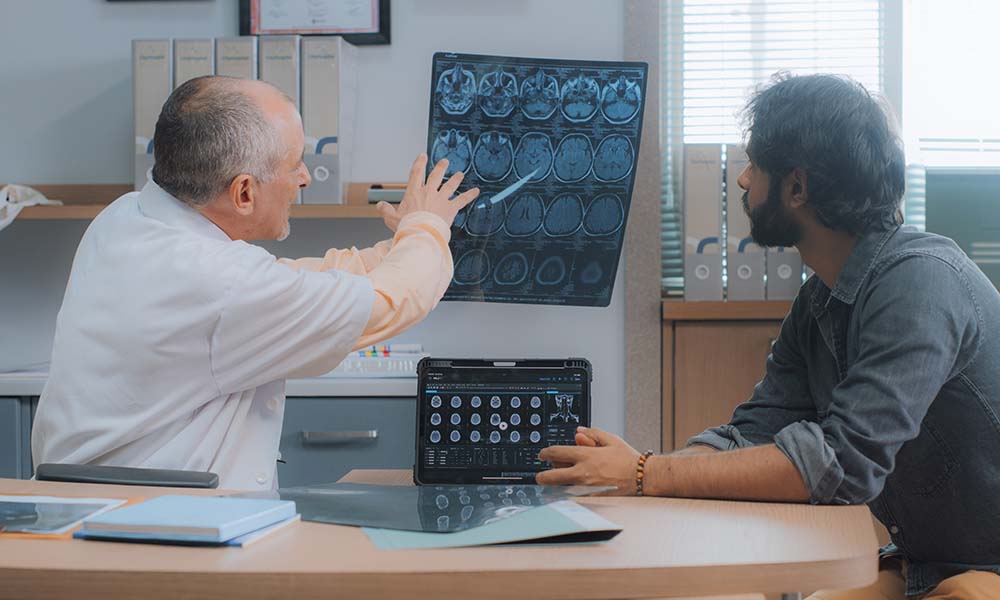Glioma: Symptoms, Types, Diagnosis, and Treatment

Overview:
A glioma is a tumor that occurs in the brain or spinal cord. It develops when glial cells proliferate rapidly. Glial cells support nerves and help in the functioning of the central nervous system. Gliomas are malignant, but a few of them can be slow growing. They’re primary brain tumors, which means they originate in the brain tissue. Gliomas don’t spread outside of the brain or spine, but they are life-threatening because they can be hard to reach and treat with surgery, and they grow into other areas of the brain. There are several types, including astrocytomas, ependymomas, and oligodendrogliomas. Gliomas can affect both children and adults, i.e., they can occur at any age. Some grow rapidly and can be life-threatening. The majority of glioma patients require a combination of therapies, consisting of surgery, radiation therapy, and chemotherapy.
Types of Glioma:
There are three main types of gliomas, classified by the type of glial cell they originate from. Some gliomas consist of multiple types of cells. These are called mixed gliomas. Each type of glioma can be classified as low-, mid-, or high-grade based on how rapidly it is growing.
Gliomas include
Astrocytomas, glioblastomas, and diffuse intrinsic pontine gliomas (DIPGs): These tumours originate from cells called astrocytes. Glioblastomas are astrocytomas that are very aggressive or grow rapidly. If the tumor is the result of an abnormal gene. Astrocytomas are also common gliomas in children. A rare but very aggressive form of brain cancer in children is diffuse intrinsic pontine gliomas. It occurs in the brain stem and mostly affects teenagers.
Ependymomas: These tumours originate from ependymocytes, a type of glial cell. Ependymomas typically develop in the spinal cord or brain ventricles. They may spread through a cerebrospinal fluid but don’t spread outside the brain or spine. Ependymomas account for around 2% of all brain tumors. They occur more commonly in youngster than adults.
Oligodendrogliomas: These tumors originate from glial cells called oligodendrocytes. Oligodendrogliomas grow slowly but can become more aggressive over time. Like ependymomas, they infrequently spread outside the brain or spine. They’re more common in adults than in children. A small percentage of all brain tumors (between 1% and 2%) are oligodendrogliomas.
Symptoms:

Symptoms of gliomas may include:
Dizziness
Nausea and vomiting
Seizures
Personality or behavioural changes
Hemiparesis (Numbness or twitching on one side of the body)
Difficulty in walking or keeping balance
Cognitive problems like trouble thinking, learning, or remembering
Changes in vision or loss of vision
Aphasia (problems with speaking)
Diagnosis:

The healthcare provider evaluates the symptoms and reviews an elaborate medical history first. Additionally, a thorough physical and neurological evaluation will be performed. The most popular imaging studies for brain tumors are MRIs and CT scans. Your healthcare provider looks for tumors in your brain as well as elsewhere in your body. An MRI and CT scan help determine the exact location and size of the lesion, which helps determine whether it can be surgically excised.
If the healthcare provider observes an abnormal mass on the imaging scans, they’ll advise or perform a biopsy. A biopsy is a procedure to analyze a sample of tissue to determine the type of glioma.
The biopsy will help them determine:
If the tumor is cancerous.
Whether the tumor was brought on by an abnormal gene.
The type of cells in the tumor.
The grade (aggressiveness) of the tumor.
Treatments:
Your glioma treatment strategy is determined by various factors, including:
The tumor's location, nature, and size.
Your age.
Your well-being and medical history.
For the majority of patients, surgery is the first line of therapy for glioma. If the tumor is easily accessible, a surgeon may be able to remove it altogether. However, gliomas can be difficult to entirely eradicate, especially in difficult-to-reach or fragile parts of the brain. In those situations, additional treatments, such as chemotherapy and radiation therapy, are undertaken. These are adjuvant therapies or can even be employed as primary treatments in cases of inoperable tumors.
Surgery:
The most common type of surgery used to eliminate gliomas is craniotomy (open brain surgery). You may be a candidate for laser ablation, depending on the size and location of the tumor. This minimally invasive surgery employs heat from a laser to kill all or part of a brain tumor.
A surgeon may employ specialized procedures to guide the surgery, such as imaging or brain mapping. This information assists your surgeon in avoiding the removal or damage of healthy brain tissue.
Radiation Therapy:
To kill cancerous cells, radiation treatment uses high doses of radiation. Radiation treatment targets the tumor's exact shape, reducing the chance of harm to nearby tissues.
You may also get brachytherapy, a type of radiation therapy. To treat a tumor, a healthcare practitioner uses radiation sources close to it. The sources emit radiation without causing damage to adjacent tissues.
Chemotherapy
Chemotherapy refers to the use of medicines to kill cancer cells. It is used to treat a wide range of cancers. This therapy can be either oral or intravenous. Temozolomide is a chemotherapeutic drug that is commonly used to boost the effectiveness of radiation treatment.
Alarming Factors:
Potentially life-threatening complications of gliomas include:
Brain haemorrhage
Brain herniation (brain tissue moves outside its normal position in the skull)
Hydrocephalus (fluid accumulation in the brain)
The pressure inside your skull
Seizures
Conclusion:
Gliomas can occur in the brain and in various locations in the nervous system, including the brain stem and spinal column. Gliomas are very rare tumors that are difficult to treat. Treatments include surgery, radiation therapy, chemotherapy, and targeted molecular therapy. It is essential for you to consult your doctor if you notice any symptoms, as early diagnosis and treatment can always yield better results. Ensure to follow up on every test, treatment, and medication prescribed by your doctor for a better quality of life with glioma.






